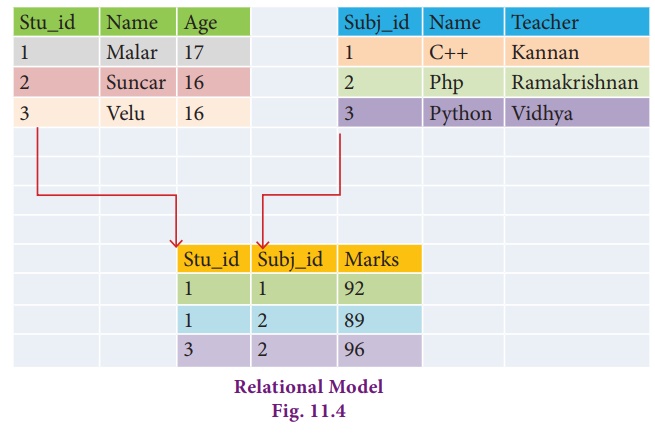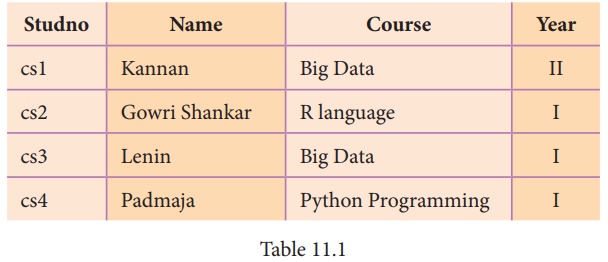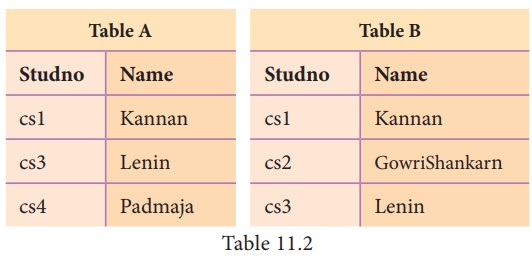Database concepts and MySql - Database Concepts: Book Back Questions and Answers | 12th Computer Science : Chapter 11 : Database concepts and MySql : Database Concepts
Chapter: 12th Computer Science : Chapter 11 : Database concepts and MySql : Database Concepts
Database Concepts: Book Back Questions and Answers
Computer Science : Database concepts and MySql : Database Concepts
Evaluation
Part – A
Choose the best answer (1 Marks)
1. What is the acronym of DBMS?
a) DataBase Management Symbol
b) Database Managing System
c) DataBase Management System
d) DataBasic Management System
2 A table is known as
a) tuple
b) attribute
c) relation
d)entity
3 Which database model represents parent-child relationship?
a) Relational
b) Network
c) Hierarchical
d) Object
4 Relational database model was first proposed by
a) E F Codd
b) E E Codd
c) E F Cadd
d) E F Codder
5 What type of relationship does hierarchical model represents?
a) one-to-one
b) one-to-many
c) many-to-one
d) many-to-many
6. Who is called Father of Relational Database from the following?
a) Chris Date
b)Hugh Darween
c) Edgar Frank Codd
d) Edgar Frank Cadd
7. Which of the following is an RDBMS?
a) Dbase
b) Foxpro
c) Microsoft Access
d) SQLite
8 What symbol is used for SELECT statement?
a) σ
b) Π
c) X
d) Ω
9 A tuple is also known as
a) table
b) row
c) attribute
d) field
10. Who developed ER model?
a) Chen
b) EF Codd
c) Chend
d) Chand
Part – B
Answer the following questions (2 Marks)
1. Mention few examples of a database.
Ans. (i) Foxpro
(ii) DBase
(iii) ADABAS
(iv) Microsoft Excel
(v) Microsoft Square
(vi) Oracle RDBMS
(vii) MySQL
2. List some examples of RDBMS.
Ans. (i) IBM DBZ
(ii) Microsoft SQL Server
(iii) Microsoft Jet Database Engine
(iv) MySQL
(v) Oracle
(vi) SQLite
3. What is data consistency?
Ans. Data Consistency means that data values are the same at all
instances of a database
4. What is the difference between Hierarchical and Network data model?
Ans. The difference between Hierarchical and Network data model is :
(i) In hierarchical model, a child record has only one parent
node,
(ii) In a Network model, a child may have many parent nodes. It
represents the data in many-to-many relationships.
(iii) This model is easier and faster to access the data.
5. What is normalization?
Ans. Database normalization is the process of structuring a
relational database in accordance with a series of so-called normal forms in
order to reduce data redundancy and improve data integrity.
Part –C
Answer the following questions (3 Marks)
1. What is the difference between Select and Project command?
Ans.

Select
It selects tuples that satisfy the given predicate from a
relation
Symbol: σ
Project
It projects column(s) that satisfy a given predicate. Duplicate
rows are automatically eliminated as relation is a set
Symbol: π
2. What is the role of DBA?
Ans. Database Administrator or DBA is the one who manages the
complete database management system. DBA takes care of the security of the
DBMS, managing the license keys, managing user accounts and access etc.
3. Explain Cartesian Product with a suitable example.
Ans. (i) Cross product is a way of combining two relations. The
resulting relation contains, both relations being combined.
(ii) A × B means A times B, where the relation A and B have
different attributes.
(iii) This type of operation is helpful to merge columns from
two relations.

4. Explain Object Model with example.
Ans. Object Model :
Object model stores the data in the form of objects, attributes and methods,
classes and inheritance. This model handles more complex applications, such as
Geographic information System (GIS), scientific experiments, engineering design
and manufacturing. It is used in file Management System. It represents real
world objects, attributes and behaviors. It provides a clear modular structure.
It is easy to maintain and modify the existing code.

An example of the Object model is Shape, Circle, Rectangle
and Triangle are all objects in this
model.
(i) Circle has the
attribute radius.
(ii) Rectangle has the attributes length and breadth.
(iii) Triangle has the attributes base and height.
(iv) The objects Circle, Rectangle and Triangle inherit from the
object Shape.
5. Write a note on different types of DBMS users.
Ans. Type of DBMS Users
(i) Database
Administrators: Database Administrator or DBA is the one who manages the
complete database management system. DBA takes care of the security of the
DBMS, managing the license keys, managing user accounts and access etc.
(ii) Application
Programmers or Software Developers : This user group is involved in
developing and designing the parts of DBMS.
(iii) End User: All modern
applications, web or mobile, store user data. Applications are programmed in
such a way that they collect user data and store the data on DBMS systems
running on their server. End users are the one who store, retrieve, update and
delete data.
(iv) Database designers:
are responsible for identifying the data to be stored in the database for
choosing appropriate structures to represent and store the data.
Part –D
Answer the following questions (5 Marks)
1. Explain the different types of data model.
Ans.The different types
of a Data Model:
Hierarchical Model, Relational Model, Network Database Model,
Entity Relationship Model, Object Model.
Hierarchical Model:
(i) Hierarchical model was developed by IBM as Information
Management System. In Hierarchical model, data is represented as a simple tree
like structure form.
(ii) This model represents a one-to-many relationship i.e.,
parent-child relationship. One child can have only one parent but one parent
can have many children.
(iii) This model is mainly used in IBM Main Frame computers.

Relational Model:
(i) The Relational Database model was first proposed by E.F.
Codd in 1970 . Nowadays, it is the most widespread data model used for database
applications around the world.
(ii) The basic structure of data in relational model is tables
(relations). All the informations related to a particular type is stored in
rows of that table.
(iii) Hence tables are also known as relations in a relational
model. A relation key is an attribute which uniquely identifies a particular
tuple (row in a relation (table)).

Network Model: Network database model is an extended form of hierarchical data
model. The difference between hierarchical and Network data model is:
(i) In hierarchical model, a child record has only one parent
node,
(ii) In a Network model, a child may have many parent nodes. It
represents the data in many-to-many relationships.
(iii) This model is easier and faster to access the data.

(iv) School represents the parent node
(v) Library, Office and Staff room is a child to school (parent
node)
(vi) Student is a child to library, office and staff room (one
to many relationship)
Entity Relationship Model. (ER
model):
(i) In this database model, relationship are created by dividing
the object into entity and its characteristics into attributes.
(ii) It was developed by Chen in 1976. This model is useful in
developing a conceptual design for the database. It is very simple and easy to
design logical view of data. The developer can easily understand the system by
looking at ER model constructed.
(iii) Rectangle represents the entities. E.g. Doctor and
Patient.
(iv) Ellipse represents the attributes E.g. D-id, D-name, P-id,
P-name. Attributes describes the characteristics and each entity becomes a major part of the data stored in the
database. Diamond represents the relationship in ER diagrams
E.g. Doctor diagnosis the Patient

Object Model:
(i) Object model stores the data in the form of objects,
attributes and methods, classes and Inheritance.
(ii)This model handles more complex applications, such as
Geographic information System (GIS), scientific experiments, engineering design
and manufacturing.
(iii) It is used in file Management System. It represents real
world objects, attributes and behaviors. It provides a clear modular structure.
It is easy to maintain and modify the existing code.

(iv) An example of the Object model is Shape, Circle, Rectangle and Triangle
are all objects in this model.
■ Circle has the attribute radius.
■ Rectangle has the attributes length and breadth.
■ Triangle has the attributes base and height.
■ The objects Circle, Rectangle and Triangle inherit from the
object Shape.
2. Explain the different types of relationship mapping.
Ans. The types of relationships used in a database.
(i) One-to-One Relationship
(ii) One-to-Many Relationship
(iii) Many-to-One Relationship
(iv) Many-to-Many Relationship
(i) One-to-One
Relationship: In One-to- One Relationship, one entity is related with only
one other entity. One row in a table is linked with only one row in another
table and vice versa.
For example : A student can have only one exam number

(ii) One-to-Many
Relationship: In One-to- Many relationship, one entity is related to many
other entities. One row in a table A is linked to many rows in a table B, but
one row in a table B is linked to only one row in table A.
For example: One Department has many staff members.

(iii) Many-to-One
Relationship: In Many- to-One Relationship, many entities can be related
with only one in the other entity.
For example: A number of
staff members working in one Department. Multiple rows in staff members table
is related with only one row in Department table.

(iv) Many-to-Many
Relationship: A many- to-many relationship occurs when multiple records in
a table are associated with multiple records in another table.
■ Example 1 : Customers and
Product
Customers can purchase various products and Products can be
purchased by many customers
■ Example 2 : Students and
Courses
A student can register for many Courses and a Course may include
many students
■ Example 3 : Books and
Student.
Many Books in a Library are issued to many students.

3. Differentiate DBMS and RDBMS.
Ans.

4. Explain the different operators in Relational algebra with suitable examples.
Ans. Relational Algebra is divided into various groups
Unary Relational Operations :
■ SELECT ( symbol: σ)
■ PROJECT ( symbol: Π)
Relational Algebra Operations
from Set Theory:
■ UNION (∪)
■INTERSECTION (∩)
■DIFFERENCE (−)
■CARTESIAN PRODUCT (X)
SELECT (Symbol: σ)
(i) General form σc(R) with a relation R and a
condition C on the attributes of R.
(ii) The SELECT operation is used for selecting a subset with
tuples according to a given condition.
(iii) Select filters out all tuples that do not satisfy C.
STUDENT:

Table A
σcourse = “Big
Data” (STUDENT ):

PROJECT (symbol: Π) :
(i) The projection eliminates all attributes of the input
relation but those mentioned in the projection list.
(ii) The projection method defines a relation that contains a
vertical subset of Relation.
(iii) Example 1 using Table A
Πcourse (STUDENT)
Result:
Course
Big Data
R language
Python Programming
Course
Big Data
R language
Python Programming
(iv) Example 2 (using Table A)
Πcourse (STUDENT)
Result:

UNION (Symbol: ∪) :
(i) It includes all tuples that are in tables A or in B. It also
eliminates duplicates. Set A Union Set B would be expressed as A ∪ B
(ii) Example 3
Consider the following tables

Result:

SET DIFFERENCE ( Symbol: -):
(i) The result of A - B, is a relation which includes all tuples
that are in A but not in B.
(ii) The attribute name of A has to match with the attribute
name in B.
(iii) Example 4 ( using
Table B):
Result:

Table A - B
cs4 Padmaja
INTERSECTION (symbol: ∩) A ∩ B
:
(i) Defines a relation consisting of a set of all tuple that are
in both in A and B. However, A and B must be union-compatible.
(ii) Example 5 (using Table B)

PRODUCT OR CARTESIAN PRODUCT
(Symbol: X)
(i) Cross product is a way of combining two relations. The
resulting relation contains, both relations being combined.
(ii) A × B means A times B, where the relation A and B have
different attributes.
(iii) This type of operation is helpful to merge columns from
two relations.


Cartesian product : Table A x Table B

5. Explain the characteristics of DBMS.
Ans.
Characteristics of Database
Management System
Data stored into Tables : Data is never directly stored into the database. Data is
stored into tables, created inside the database. DBMS also allows to have
relationship between tables which makes the data more meaningful and connected.
Reduced Redundancy : In the modern world hard drives are very cheap, but earlier
when hard drives were too expensive, unnecessary repetition of data in database
was a big problem But DBMS follows Normalisation which divides the data in such
a way that repetition is minimum.
Data Consistency : On live data, it is being continuously updated and added,
maintaining the consistency of data can become a challenge. But DBMS handles it
by itself.
Support Multiple user and
Concurrent Access : DBMS allows multiple users to work
on it(update, insert, delete data) at the same time and still manages to
maintain the data consistency.
Query Language : DBMS provides users with a simple query language, using which
data can be easily fetched, inserted, deleted and updated in a database.
Security : The DBMS also takes care of the security of data, protecting
the data from unauthorized access. In a typical DBMS, we can create user
accounts with different access permissions, using which we can easily secure
our data by restricting user access.
DBMS Supports Transactions : It allows us to better handle and manage data integrity in
real world applications where multi-threading is extensively used.
Related Topics